Generative AI is revolutionizing the landscape of artificial intelligence, offering unprecedented capabilities in creating diverse content ranging from text to images and beyond. This cutting-edge technology has the power to transform industries, enhance creativity, and streamline complex processes. As businesses and individuals alike seek to harness the potential of generative AI, understanding its fundamentals, tools, and applications has become crucial in today’s rapidly evolving digital world.
At the end of this post, you can download our Generative AI PowerPoint template to fit your purpose. As the same diagram PowerPoint template series, you can also find our Circular Economy, Blue Sea Strategy, 2025 Calendar with Holidays, The 7 Habits of Highly Effective People, Six Thinking Hats, Pareto Chart, Occam’s Razor, Data Mining, marketing segment, Porter’s five forces, SWOT Analysis, GE Matrix, BCG Matrix, Artificial Intelligence, National Diamond and BlockChain PowerPoint templates.
This article delves into the realm of generative AI, exploring its core concepts, popular models, and essential tools. It examines practical use cases across various sectors, including marketing and advertising, while addressing the challenges and ethical considerations associated with this technology. By the end, readers will gain valuable insights into mastering generative AI, equipping them with the knowledge to navigate this transformative field and leverage its capabilities effectively in their respective domains.
Understanding Generative AI Fundamentals
What is Generative AI?
Generative AI is a cutting-edge technology that has the ability to create new and original content based on natural language input. This revolutionary form of artificial intelligence can produce a wide range of outputs, including text, images, audio, and video. The core principle behind generative AI is its capacity to learn patterns and structures from existing data, enabling it to generate content that closely resembles human-created work.
At its heart, generative AI relies on machine learning models trained on vast datasets. These models analyze and process the input data to identify underlying patterns and relationships. By leveraging this learned knowledge, generative AI can produce contextually relevant and coherent content in response to user prompts or instructions.
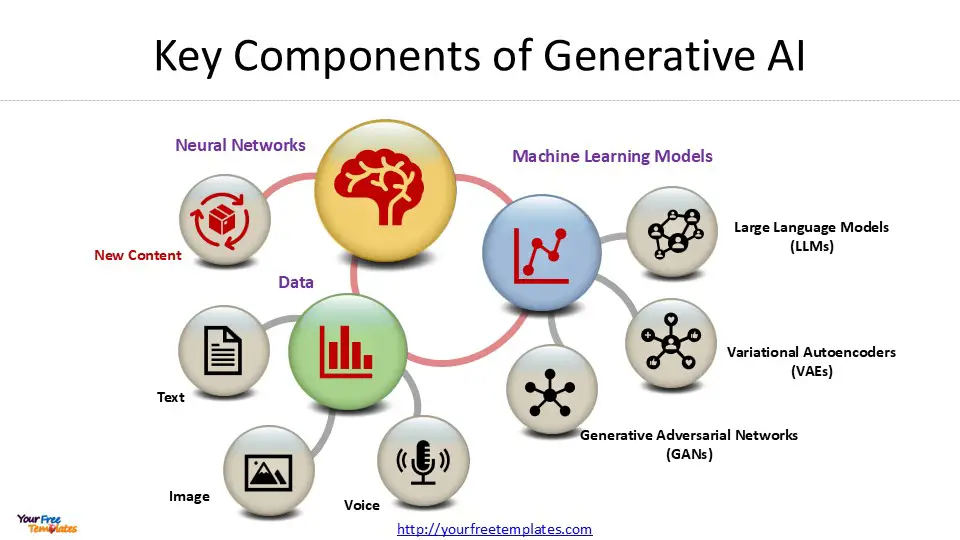
Key Components of Generative AI
To understand generative AI better, it’s essential to explore its key components:
- Data: The foundation of any generative AI system is the data it’s trained on. These datasets can be diverse, encompassing text, images, audio, or other forms of information. The quality and quantity of data significantly influence the model’s performance and output.
- Machine Learning Models: Generative AI employs various types of machine learning models, each with its unique strengths. Some popular models include:
- Generative Adversarial Networks (GANs): These models consist of two competing neural networks—a generator and a discriminator. The generator creates new content, while the discriminator evaluates its authenticity.
- Variational Autoencoders (VAEs): These models compress input data into a lower-dimensional representation and then reconstruct it, allowing for the generation of new, similar content.
- Large Language Models (LLMs): These models, such as GPT (Generative Pre-trained Transformer), are trained on massive text datasets to understand and generate human-like text.
- Neural Networks: At the core of generative AI are artificial neural networks, inspired by the structure and function of the human brain. These networks process and learn from data, enabling the AI to recognize patterns and generate new content.
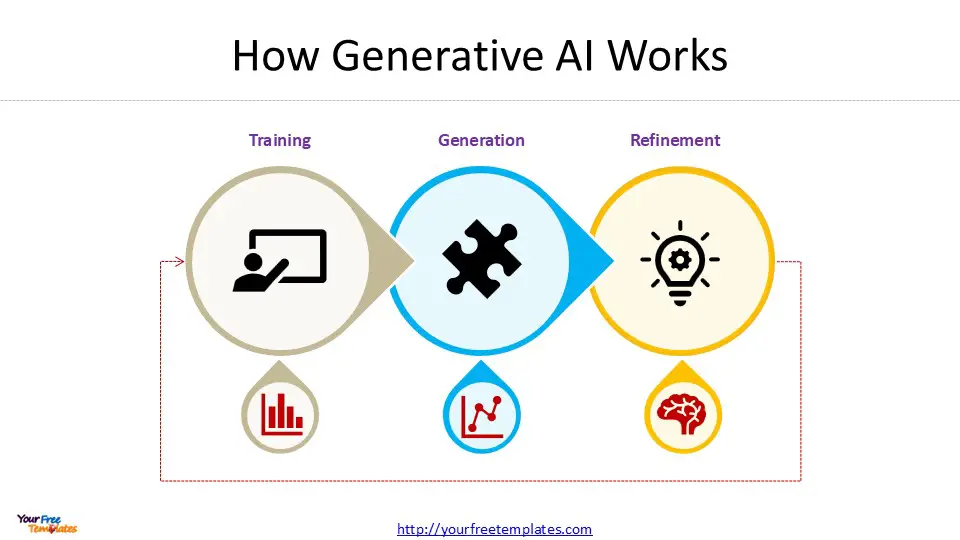
How Generative AI Works
Generative AI operates through a process of training and generation:
- Training: During this phase, the AI model is exposed to large amounts of data. It analyzes this data to learn patterns, structures, and relationships. For example, a text-based model might learn grammar rules, writing styles, and contextual information.
- Generation: Once trained, the model can create new content based on user prompts or inputs. It uses its learned knowledge to produce statistically probable outputs that align with the patterns it has identified.
- Refinement: Many generative AI systems incorporate feedback loops, allowing them to improve their outputs based on user interactions or additional training.
The effectiveness of generative AI stems from its ability to understand context and generate relevant, coherent content. This capability has led to its application across various fields, including marketing, software development, creative arts, and scientific research.
As generative AI continues to evolve, it presents both exciting opportunities and important ethical considerations. While it offers tremendous potential for innovation and creativity, it also raises questions about originality, copyright, and the potential for misuse. As this technology advances, it’s crucial to approach its development and application with careful consideration of its impacts on society and various industries.
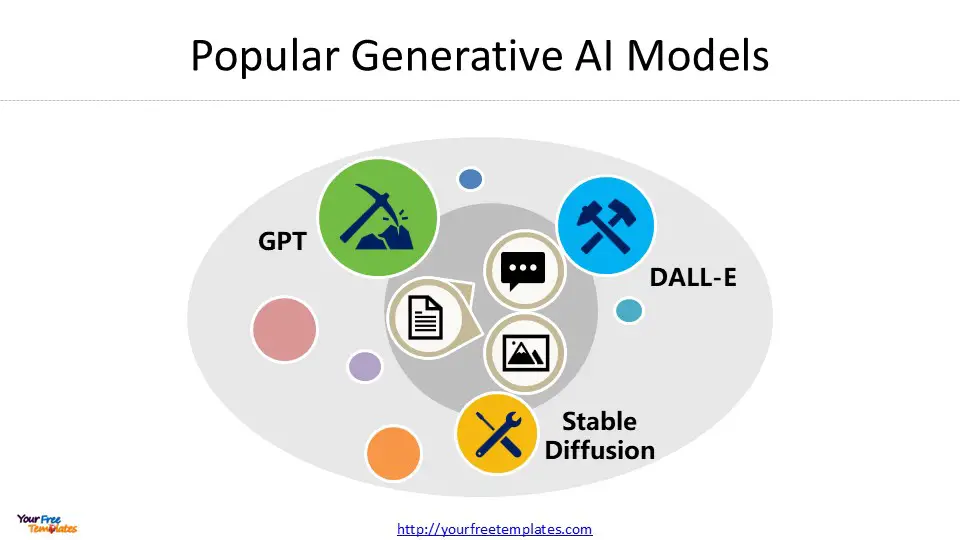
Popular Generative AI Models
Generative AI has seen remarkable advancements in recent years, with several models gaining prominence for their ability to create diverse content. These models have revolutionized various industries and opened up new possibilities for creativity and innovation. Let’s explore some of the most influential generative AI models that have made significant impacts in the field.
GPT (Generative Pre-trained Transformer)
The Generative Pre-trained Transformer (GPT) series, developed by OpenAI, has become a cornerstone in the realm of natural language processing. GPT models are large language models that use deep learning to produce human-like text based on given inputs. These models have been trained on vast amounts of text data, allowing them to learn complex linguistic patterns and associations.
The GPT series has evolved rapidly, with each iteration showcasing significant improvements in capabilities and performance. GPT-3, released in 2020, was a groundbreaking model with 175 billion parameters, making it one of the largest and most sophisticated language models at the time 1. Its ability to generate coherent and contextually relevant text across various domains has led to its application in chatbots, content creation, and even code generation.
The latest iteration, GPT-4, released in March 2023, has further pushed the boundaries of what’s possible with generative AI. It offers enhanced capabilities in understanding context, following instructions, and generating more nuanced and accurate responses. GPT-4 can be accessed through ChatGPT, a conversational AI system that has gained widespread popularity for its ability to engage in human-like dialog and assist with various tasks.
DALL-E
DALL-E, another creation by OpenAI, is a generative AI model designed to create images from textual descriptions. This model has garnered significant attention for its ability to generate highly creative and often surreal images based on complex prompts. DALL-E demonstrates the potential of AI to not only understand language but also to translate it into visual representations.
The latest version, DALL-E 3, represents a significant leap forward in image generation capabilities. It offers improved understanding of nuance and detail in text prompts, allowing for the creation of exceptionally accurate images that adhere closely to the provided descriptions 2. DALL-E 3 is integrated with ChatGPT, enabling users to refine their prompts and generate tailored, detailed images with ease.
One of the key features of DALL-E 3 is its ability to generate images that are not only visually appealing but also contextually appropriate. The model has been designed with safety considerations in mind, including measures to decline requests for generating images of public figures and to avoid harmful biases related to visual representation 2.
Stable Diffusion
Stable Diffusion is an open-source text-to-image model that has gained popularity for its accessibility and versatility. Developed by Stability AI, CompVis, and LAION, Stable Diffusion uses a latent diffusion model to generate detailed images from text descriptions. What sets Stable Diffusion apart is its ability to run on consumer hardware with modest GPU requirements, making it more accessible to individual users and developers 3.
The model has been trained on a diverse dataset of image-text pairs, allowing it to generate a wide range of visual styles and concepts. Stable Diffusion supports various tasks beyond basic image generation, including inpainting, outpainting, and image-to-image translations guided by text prompts 3.
One of the strengths of Stable Diffusion is its open-source nature, which has fostered a vibrant community of developers and artists who continue to improve and expand upon the model’s capabilities. This has led to the creation of numerous variations and fine-tuned models tailored for specific use cases or artistic styles.
As these generative AI models continue to evolve, they are reshaping the landscape of content creation, artistic expression, and problem-solving across various industries. While each model has its unique strengths and applications, they all share the common goal of pushing the boundaries of what’s possible with artificial intelligence, opening up new avenues for creativity and innovation in the digital age.
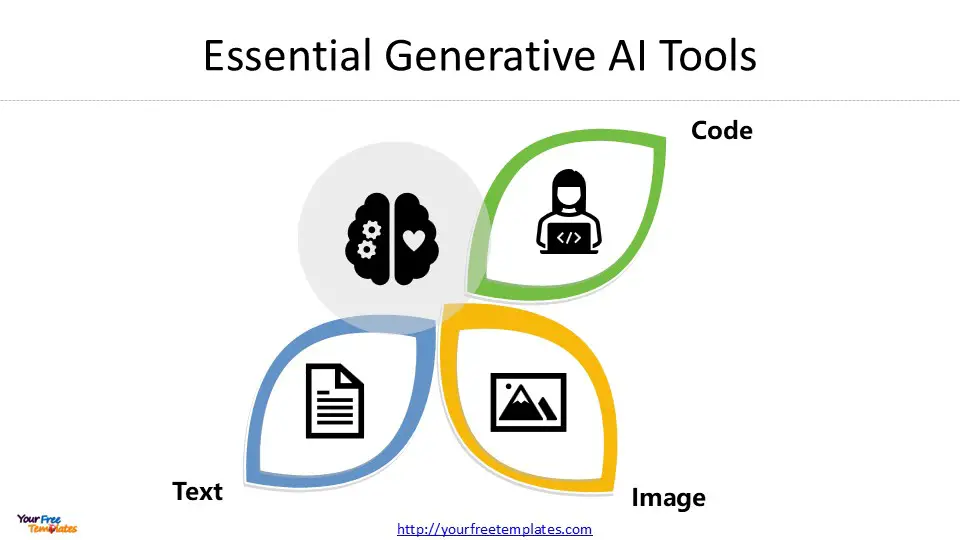
Essential Generative AI Tools
Generative AI has revolutionized content creation across various domains, offering powerful tools that enhance creativity and productivity. These tools have become indispensable for businesses and individuals alike, providing innovative solutions for text, image, and code generation.
Text Generation Tools
Text generation tools have become increasingly sophisticated, offering capabilities that range from simple content creation to complex language understanding. ChatGPT, developed by OpenAI, has emerged as a leading name in this field. Its exceptional text generation capabilities make it widely used in customer support, creative writing, and various applications requiring coherent and contextually relevant text 1. ChatGPT’s ability to understand and generate human-like text has made it a valuable asset for businesses looking to streamline their operations and boost creative output.
Another notable player in the text generation landscape is Bard, developed by Google. Released in February 2023, Bard offers a range of features for content creation and natural language understanding 1. Its integration with Google’s vast knowledge base allows it to provide up-to-date information and assist with various tasks, from answering queries to helping with programming and software development.
For those seeking a more specialized text generation tool, Claude 2, developed by Anthropic, stands out with its strong focus on helpfulness, fairness, and safety 1. This AI assistant is designed to provide reliable and ethical responses, making it suitable for applications where trust and accuracy are paramount.
Image Generation Tools
The field of AI-powered image generation has seen remarkable advancements, with tools like DALL-E 2 leading the charge. Developed by OpenAI, DALL-E 2 uses advanced algorithms to create high-quality images from textual descriptions 1. Its ability to generate creative and visually appealing images has made it a top choice for artists and designers looking to expand their creative horizons.
Midjourney is another powerful image generation tool that has gained popularity among creators. Initially known for its complexity, Midjourney has significantly simplified its user interface, making it more accessible to a broader audience 3. The tool now offers a standalone webpage that allows users to easily generate stunning visuals from text prompts.
For those seeking a more commercially safe option, Generative AI by Getty Images offers a unique solution. This tool generates images using content solely from Getty Images’ vast creative library, providing full indemnification for commercial use 3. This approach addresses concerns about copyright and ensures that businesses can confidently use AI-generated images in their marketing and branding efforts.
Code Generation Tools
In the realm of software development, AI-powered code generation tools have become invaluable assets for programmers. GitHub Copilot, developed in partnership with OpenAI, stands out as a leading code completion tool. Trained on all programming languages in public repositories, Copilot offers strong support for languages like JavaScript, providing developers with autocomplete-style code suggestions and natural language comment interpretations 1.
For those engaged in competitive programming or seeking novel solutions, AlphaCode, developed by DeepMind, offers impressive capabilities. Tested during recent contests on Codeforces, AlphaCode is designed to generate innovative programming solutions, a critical requirement in competitive coding scenarios 1.
As generative AI tools continue to evolve, they present both exciting opportunities and important ethical considerations. While they offer tremendous potential for innovation and creativity across text, image, and code generation, it’s crucial to approach their development and application with careful consideration of their impacts on society and various industries.
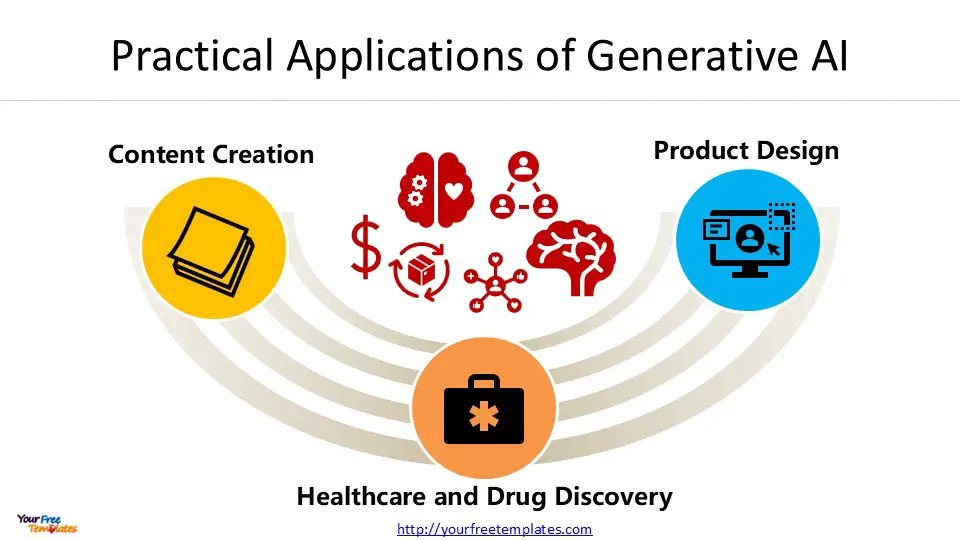
Practical Applications of Generative AI
Generative AI has emerged as a transformative force across various industries, offering innovative solutions and enhancing productivity in numerous fields. From healthcare to content creation, this technology is revolutionizing the way we approach complex problems and creative tasks.
Content Creation
One of the most prominent applications of generative AI is in content creation. This technology has become an invaluable tool for marketers, writers, and designers, streamlining the creative process and enhancing productivity. Generative AI models can produce a wide range of content, including articles, blog posts, social media updates, and even visual assets.
For instance, Jasper, a marketing-focused version of GPT-3, can generate blogs, social media posts, web copy, sales emails, ads, and other types of customer-facing content 1. This capability allows businesses to create diverse and engaging content at scale, saving time and resources while maintaining quality.
Moreover, generative AI enables personalized content creation tailored to individual preferences and interests. This level of customization can significantly enhance user engagement and improve the effectiveness of marketing campaigns. By analyzing user data and preferences, AI models can generate highly relevant content, from social media posts to product recommendations 1.
Product Design
Generative AI is revolutionizing product design across various industries, offering innovative solutions and streamlining the design process. This technology enables designers to explore a broader range of possibilities and iterate faster, leading to more creative and efficient product development.
In the fashion industry, companies like Stitch Fix are experimenting with DALL-E 2 to create visualizations of clothing based on customer preferences for color, fabric, and style 1. This application of generative AI allows for rapid prototyping and personalized design concepts, potentially transforming the way fashion brands approach product development.
Similarly, toy manufacturer Mattel is leveraging generative AI technology to generate images for toy design and marketing 1. This approach not only accelerates the design process but also opens up new avenues for creativity and innovation in product development.
Healthcare and Drug Discovery
Generative AI is making significant strides in healthcare, particularly in drug discovery and development. The technology’s ability to analyze vast amounts of data and generate novel solutions is proving invaluable in accelerating the typically lengthy and costly process of bringing new drugs to market.
According to estimates, generative AI has the potential to cut the time needed to design and screen new drugs almost by half, potentially saving the pharmaceutical industry around USD 26.00 billion in annual expenses 2. Additionally, this technology could reduce costs associated with clinical trials by USD 28.00 billion per year 2.
Generative AI models are being used to design and generate new molecules with desired properties, predict the properties of novel drug candidates, and forecast potential side effects. For instance, researchers at the University of Toronto built a generative AI system called ProteinSGM that can generate novel, realistic proteins after studying imagery representations of existing protein structures 2. This capability could significantly accelerate the discovery of new therapeutic proteins and enzymes.
Moreover, generative AI is enhancing personalized medicine by analyzing patient data and generating tailored treatment plans. AI models can serve as medical chatbots, understanding patients’ symptoms and producing diagnoses with increasing accuracy based on patient declarations and test results 3. This application of generative AI has the potential to revolutionize patient care, offering more precise and effective treatment strategies.
As generative AI continues to evolve, its practical applications across content creation, product design, and healthcare are likely to expand further, driving innovation and efficiency across industries.
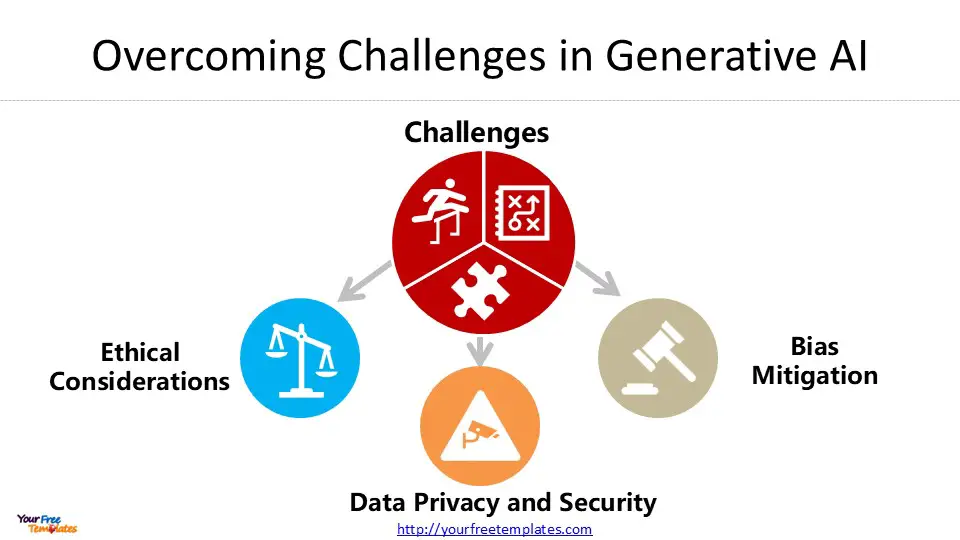
Overcoming Challenges in Generative AI
Ethical Considerations
As generative AI continues to evolve and become more integrated into various aspects of our lives, it brings forth a myriad of ethical considerations that need to be addressed. One of the primary concerns is the potential for these systems to perpetuate and amplify existing societal biases. For instance, a study published in the academic journal Digital Medicine revealed that large language models, which power generative AI, have a tendency to output responses that perpetuate race-based medicine when integrated into healthcare systems 1.
The impact of bias in generative AI extends beyond healthcare. According to a TELUS Digital survey, almost one-third (32%) of respondents believe that bias within a generative AI algorithm caused them to miss out on opportunities, such as financial application approvals or job prospects 2. This highlights the urgent need for developers and deployers of generative AI to prioritize bias mitigation strategies.
Data Privacy and Security
Data privacy and security have become paramount concerns in the realm of generative AI. The vast amounts of data required to train these models raise questions about the ethical collection and use of personal information. There is a risk that training data may include information collected in violation of copyright and privacy laws, potentially contaminating the model and any products that use it.
Moreover, the interactive and conversational nature of many generative AI applications may lead users to overshare personal information inadvertently. It remains unclear what personal information, user behavior, and analytics are being recorded, retained, or shared with third parties. As generative AI becomes more mainstream, it is likely to follow proven channels for monetization, such as using personal data for targeted advertising.
Bias Mitigation
Addressing bias in generative AI is crucial for ensuring fair and equitable outcomes. One effective strategy is to source training data broadly, using high-quality data from multiple trusted sources. This helps ensure that the model learns from various perspectives, reducing the risk of perpetuating biases present in limited datasets.
Another important approach is to diversify the fine-tuning process. By involving a team with diverse backgrounds in the fine-tuning and evaluation of generative AI models, organizations can produce more balanced results. As Steve Nemzer, TELUS Digital’s director of AI growth and innovation, stated, “It’s good practice to encourage a wide range of backgrounds among your fine-tuning and red teaming analyst pools by region, by language and by expertise” 3.
Continuous evaluation of the model in operation is also crucial. The way a model performs in training versus the real world can differ due to data shift. By monitoring the model’s operational performance and further fine-tuning as necessary, organizations can quickly identify and correct any signs of biased output.
Implementing these strategies not only serves the end user but also benefits organizations. A generative AI model that outputs biased decisions performs suboptimally for businesses. Furthermore, demonstrating a commitment to responsible AI practices fosters trust with customers and can serve as a competitive advantage in the rapidly evolving landscape of artificial intelligence.
Conclusion
Generative AI has a profound influence on various industries, from content creation to healthcare and product design. Its ability to generate human-like text, create stunning visuals, and even assist in drug discovery has opened up new possibilities to innovate and boost productivity. As this technology continues to evolve, it presents both exciting opportunities and important challenges to consider, including ethical concerns, data privacy, and bias mitigation.
To wrap up, mastering generative AI involves understanding its fundamentals, exploring popular models, and leveraging essential tools while being mindful of its practical applications and potential pitfalls. As we move forward, it’s crucial to approach the development and use of generative AI with careful thought, ensuring that we harness its potential responsibly and ethically. This balanced approach will help us make the most of this groundbreaking technology while addressing its challenges head-on.
FAQs
What are the primary applications of generative AI?
Generative AI is widely used to enhance customer interactions through chatbots and virtual assistants, increase employee efficiency with tools like employee assistants, and expedite document processing for faster process optimization.
How does generative AI assist in model design?
Generative AI facilitates the rapid creation of multiple design prototypes by incorporating specific inputs and constraints. It can also refine existing designs by integrating user feedback and predefined constraints to streamline the ideation phase.
Which AI model type is employed in generative AI?
Generative Adversarial Networks (GANs) are commonly used in generative AI. These involve two neural networks, the generator and the discriminator, which are trained together through adversarial learning. This process allows the generator to create increasingly realistic data.
What is considered best practice in the use of generative AI?
A best practice in utilizing generative AI includes maintaining human involvement in the review and oversight of AI-generated content and solutions. This approach ensures ethical usage and promotes accountability in AI operations.
Need premium maps, pls visit our map shop: https://editablemaps.com https://ofomaps.com
Size:580K
Type: PPTX
Generative AI Template
Click the link to download it.
Aspect Ratio: Standard 4:3
Click the blue button to download it.
Download the 4:3 Template
Aspect Ratio: Widescreen 16:9
Click the green button to download it.
Download the 16:9 Template
References
[1] – https://www.cloudskillsboost.google/course_templates/536
[2] – https://www.coursera.org/learn/introduction-to-generative-ai
[3] – https://cloud.google.com/blog/topics/training-certifications/new-generative-ai-trainings-from-google-cloud














